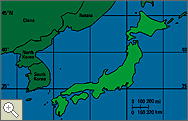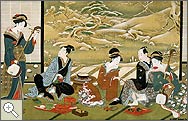
Geography
Japan is a crescent-shaped archipelago of four large and more than a thousand small islands. The large islands are Hokkaido, the northernmost; Honshu, the largest; Shikoku; and Kyushu. The combined area of the islands is about 145,000 square miles, which is larger than the state of California or the country of Italy. If it were superimposed over the East Coast of the United States, the group of islands would cover a space from Maine to Florida.
Japan is bordered on the north by the Sea of Okhotsk, on the east by the Pacific Ocean, and on the west by the Tsushima Strait, the Sea of Japan, and the East China Sea. No part of Japan is more than one hundred miles from the sea. Most of the land is mountainous, leaving only the coastal areas for large cities, industrial development, and farming.
Because of Japan's location in an unstable area of the Earth's crust, earthquakes and tremors occur there frequently. Undersea quakes can cause destructive tidal waves called tsunami. Some volcanic mountains are still active, and there are many hot springs, which the Japanese people use for recreational and medicinal purposes.
Climate
Just as the climate from Maine to Florida varies, so does the climate vary from the northernmost to the southernmost islands of Japan. Most of Japan has four seasons: winter (December to February), with heavy snow only on Hokkaido and Honshu; spring (March to May); summer (June to September) with hot and humid conditions; and fall (October to November). Much rain falls during the spring, summer, and fall. The precipitation starts first in the south and moves north during June and July, and destructive tropical storms called typhoons occur in September and October.
Vegetation
Because of the hot, humid summers there, more than 17,000 varieties of plants grow in Japan. Many trees thrive, including broad-leafed evergreens such as camellia, deciduous beech and oak, and conifers. Bamboo grows on Honshu and on the islands to the south. Many flowering plants flourish: azaleas and tree peonies bloom in April and May, respectively; the lotus in August; the chrysanthemum (Japan's national flower) in November; and the plum in February.
|
 |
 |
 |
 |

Map of Japan and adjacent areas of the Asian mainland.
|
 |
 |
 |
 |
 |
 |

Winter Party: By Utagawa Toyoharu
|
 |
 |

Ukiyo-e school, Edo period, eighteenth-ninenteenth century
Ink , color and gold on silk
Freer Gallery of Art
accession number 00.113
52.7 x 96.3 cm (20 3/4 x 37 15/16")
1997 Freer Gallery of Art, Smithsonian Institution
|
 |
 |
 |
|

